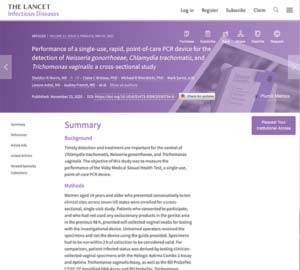Authors: Sheldon R Morris, MD; Claire C Bristow, PhD; Michael R Wierzbicki, PhD; Mark Sarno, eJD; Lenore Asbel, MD; Audrey French, MD; Charlotte A Gaydos, DrPH; Lydie Hazan, MD; Leandro Mena, MD; Purnima Madhivanan, MD; Susan Philip, MD; Saara Schwartz, MD; Constance Brown, MD; David Styers, BS; Toni Waymer, BA; Jeffrey D Klausner, MD
Published: November 23, 2020
Summary:
Background
Timely detection and treatment are important for the control of Chlamydia trachomatis, Neisseria gonorrhoeae, and Trichomonas vaginalis. The objective of this study was to measure the performance of the Visby Medical Sexual Health Test, a single-use, point-of-care PCR device.
Methods
Women aged 14 years and older who presented consecutively to ten clinical sites across seven US states were enrolled for a cross-sectional, single-visit study. Patients who consented to participate, and who had not used any exclusionary products in the genital area in the previous 48 h, provided self-collected vaginal swabs for testing with the investigational device. Untrained operators received the specimens and ran the device using the guide provided. Specimens had to be run within 2 h of collection to be considered valid. For comparison, patient-infected status was derived by testing clinician-collected vaginal specimens with the Hologic Aptima Combo 2 Assay and Aptima Trichomonas vaginalis Assay, as well as the BD ProbeTec CT/GC Qx Amplified DNA Assay and BD ProbeTec Trichomonas vaginalis Qx Assay. If the results of those assays did not match, the BD MAX CT/GC/TV was used as a tiebreaker. The primary outcomes were the sensitivity and specificity of the investigational device for the detection of C trachomatis, N gonorrhoeae, and T vaginalis compared with patient-infected status.
Findings
Between Feb 25, 2019, and Jan 6, 2020, 1585 participants aged between 14 years and 80 years (mean 34·8 [SD 14·2]) were enrolled. 1555 participants had tests run with the investigational device, of whom 1532 (98·5%) had a valid result on either the first or repeat test. Among the patients with evaluable results (including a determinate patient-infected status), the device had a sensitivity of 97·6% (95% CI 93·2–99·2) and specificity of 98·3% (97·5–98·9) for C trachomatis (n=1457), sensitivity of 97·4% (86·5–99·5) and specificity of 99·4% (98·9–99·7) for N gonorrhoeae (n=1468), and sensitivity of 99·2% (95·5–99·9) and specificity of 96·9% (95·8–97·7) for T vaginalis (n=1449).
Interpretation
This innovative, rapid, easy-to-use, single-use, point-of-care device to detect C trachomatis, N gonorrhoeae, and T vaginalis infections showed excellent sensitivity and specificity, and could represent an important advance in the development of rapid diagnostics for sexually transmitted infections and other infectious diseases.
Funding
Division of Microbiology and Infectious Diseases, National Institute of Allergy and Infectious Diseases.
See the full article here:


